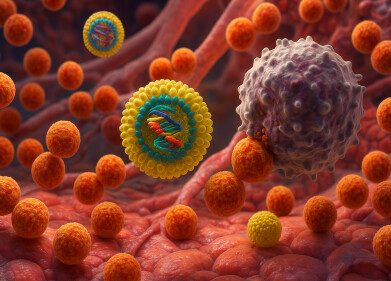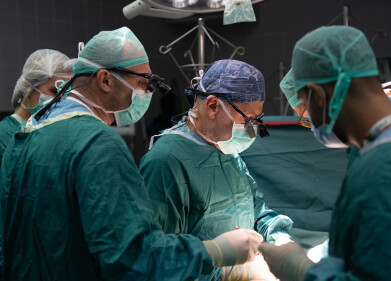-
 Using SLAC’s X-ray laser, researchers have finally seen the process by which nature creates the oxygen we breathe (Credit: Greg Stewart SLAC National Accelerator)
Using SLAC’s X-ray laser, researchers have finally seen the process by which nature creates the oxygen we breathe (Credit: Greg Stewart SLAC National Accelerator)
News
Elusive Missing Step in Photosynthesis Cycle Captured
Jun 22 2023
Crucial in shaping and sustaining life on Earth some aspects of how photosynthesis works are still unclear. One of these mysteries includes how Photosystem II, a protein complex in plants, algae and cyanobacteria, harvests energy from sunlight and uses it to split water, to produce the oxygen we breathe.
Now researchers from the Department of Energy’s SLAC National Accelerator Laboratory and Lawrence Berkeley National Laboratory, together with collaborators from Uppsala University, Humboldt University and other institutions have succeeded in cracking a key secret of Photosystem II.
Using SLAC’s Linac Coherent Light Source (LCLS) and the SPring-8 Angstrom Compact free electron LAser (SACLA) in Japan, the researchers were able to see for the first time in atomic detail what happens in the final moments leading up to the release of breathable oxygen. The results are helping scientists develop artificial photosynthetic systems that mimic photosynthesis to harvest natural sunlight to convert carbon dioxide into hydrogen and carbon-based fuels.
“The more we learn about how nature does it, the closer we get to using those same principles in human-made processes, including ideas for artificial photosynthesis as a clean and sustainable energy source,” said co-author Jan Kern, a scientist at Berkeley Lab.
Co-author Junko Yano, also at Berkeley Lab, said, “Photosystem II is giving us the blueprint for how to optimise our clean energy sources and avoid dead ends and dangerous side products that damage the system. What we once thought was just fundamental science could become a promising avenue to improving our energy technologies.”
During photosynthesis, Photosystem II’s oxygen-evolving centre – a cluster of four manganese atoms and one calcium atom connected by oxygen atoms – facilitates a series of challenging chemical reactions that act to split apart a water molecule to release molecular oxygen.
The centre cycles through four stable oxidation states, known as S0 through S3, when exposed to sunlight. Likening this to a baseball field scenario S0 would be the start of the game when a player on home base is ready to go to bat. S1-S3 would be players on first, second and third. Every time a batter connects with a ball, or the complex absorbs a photon of sunlight, the player on the field advances one base. When the fourth ball is hit, the player slides into home, scoring a run or, in the case of Photosystem II, releasing one molecule of breathable oxygen.
In their experiments, the researchers probed this centre by exciting samples from cyanobacteria with optical light and then probing them with ultrafast X-ray pulses from LCLS and SACLA. The data revealed the atomic structure of the cluster and the chemical process around it.
Using this technique, the scientists for the first time imaged the mad dash for home – the transient state, or S4, where two atoms of oxygen bond together and an oxygen molecule is released. The data showed that there are additional steps in this reaction that had never been seen before.
“Other experts argued that this is something that could never be captured,” said co-author Uwe Bergmann, a scientist and professor at the University of Wisconsin-Madison. “It’s really going to change the way we think about Photosystem II. Although we can't say we have a unique mechanism based on the data yet, we can exclude some models and ideas people have proposed over the last few decades. It’s the closest anyone has ever come to capturing this final step and showing how this process works with actual structural data.”
The new study is the latest in a series undertaken by the team over the past decade.
“Most of the process that produces breathable oxygen happens in this last step,” said co-author Vittal Yachandra, a scientist at Berkeley Lab. “But there are several things happening at different parts of Photosystem II and they all have to come together in the end for the reaction to succeed. Just like how in baseball, factors like the location of the ball and the position of the basemen and fielders affect the moves a player takes to get to home base, the protein environment around the catalytic centre influences how this reaction plays out.”
Based on these results, the researchers plan to conduct experiments designed to capture many more snapshots of the process.
More information online
Digital Edition
Lab Asia Dec 2025
December 2025
Chromatography Articles- Cutting-edge sample preparation tools help laboratories to stay ahead of the curveMass Spectrometry & Spectroscopy Articles- Unlocking the complexity of metabolomics: Pushi...
View all digital editions
Events
Jan 21 2026 Tokyo, Japan
Jan 28 2026 Tokyo, Japan
Jan 29 2026 New Delhi, India
Feb 07 2026 Boston, MA, USA
Asia Pharma Expo/Asia Lab Expo
Feb 12 2026 Dhaka, Bangladesh


















